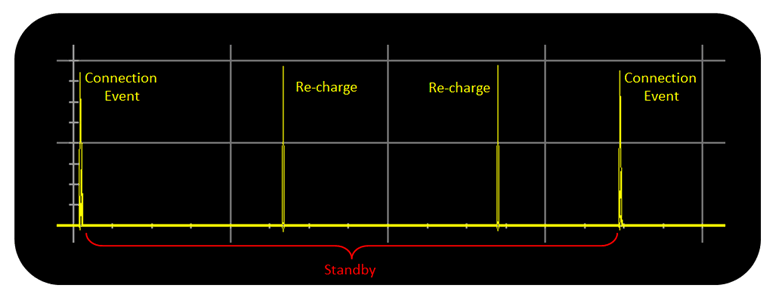SWRA478D February 2015 – January 2019 CC1310 , CC1312PSIP , CC1312R , CC1314R10 , CC1352P , CC1352P7 , CC1352R , CC2640 , CC2640R2F , CC2640R2F-Q1 , CC2642R , CC2642R-Q1 , CC2650 , CC2650MODA , CC2652P , CC2652R , CC2652R7 , CC2652RB , CC2652RSIP
3 Understanding Bluetooth Low Energy Power Metrics
A Bluetooth Low Energy device achieves low power consumption by keeping radio activity short and allowing the device to reside in Standby or Power Down mode most of the operating time.
The operation of a Bluetooth Low Energy device is typically static in the sense that it’s staying in a certain mode for a certain amount of time, for example, when advertising or maintaining a connection. These modes are based on re-occurring events that can easily be used to estimated average power consumption. Each of these modes can be quantified into states for future estimations based on added data throughput or reduced latency (through higher connection interval, as an example).
The primary metric is the average current for the advertising and connected mode. It is these values that can be used to determine the battery life of a Bluetooth Low Energy device.
For a wireless MCU it is important to understand that the device is typically not only running the Bluetooth Low Energy protocol stack, but also profile services and an application. The application may also be using peripherals on the chip, such as serial peripheral interface (SPI) or analog-to-digital converter (ADC). In addition, other devices on the circuit board, aside from the device running the Bluetooth Low Energy protocol stack, may be drawing current as well.
There are three main components of a Bluetooth Low Energy application that together sum up the average power consumption: Standby, Protocol events and Application events. Depending on the use case of the Bluetooth Low Energy device, these components will consume different amounts of power.
Figure 3-1 shows the current profile for a connected Bluetooth Low Energy device. The device spends most of the time in Standby, where the average current consumption is around 1 µA (see [4] through [13]).
 Figure 3-1 Current Consumption vs. Time During a Bluetooth Low Energy Connection
Figure 3-1 Current Consumption vs. Time During a Bluetooth Low Energy ConnectionFrom Standby, the device only wakes up based on either external interrupts or scheduled events/interrupts from the RTC. Standby also includes the recharge, which is described in Section 2.
The Protocol event is where communication over the Bluetooth Low Energy protocol occurs. For a Bluetooth Low Energy device, these events can be either Advertising events or Connection events. There are multiple roles featured that allow a Bluetooth Low Energy device to enter Observer role and scan as well but they are not covered in this application report
The Application event is the application-specific implementation, for example, a periodic event, serial communication, or running algorithms based on sensor inputs. Depending on the amount of activity, the application event can increase power consumption significantly, hence, always aim to optimize processing usage. The Application events typically occur between protocol events, which mean that a longer advertising or connection interval gives longer time slots for processing.